
Custom Inwall
CWMLCR8
Owner’s Manual
and Warranty
Page is loading ...
Page is loading ...
Page is loading ...

English
Limited Warranty
Dear customer, welcome to B&W.
This product has been designed and
manufactured to the highest quality
standards. However, if something does go
wrong with this product, B&W
Loudspeakers and its national distributors
warrant free of charge labour (exclusion
may apply) and replacement parts in any
country served by an official B&W
distributor.
This limited warranty is valid for a period of
five years from the date of purchase or two
years for electronics including amplified
loudspeakers.
Terms and Conditions
1 The warranty is limited to the repair of
the equipment. Neither transportation,
nor any other costs, nor any risk for
removal, transportation and installation
of products is covered by this warranty.
2 This warranty is only valid for the
original owner. It is not transferable.
3 This warranty will not be applicable in
cases other than defects in materials
and/or workmanship at the time of
purchase and will not be applicable:
a. for damages caused by incorrect
installation, connection or packing,
b. for damages caused by any use other
than correct use described in the user
manual, negligence, modifications, or
use of parts that are not made or
authorised by B&W,
c. for damages caused by faulty or
unsuitable ancillary equipment,
d. for damages caused by accidents,
lightning, water, fire heat, war, public
disturbances or any other cause
beyond the reasonable control of B&W
and its appointed distributors,
e. for products whose serial number has
been altered, deleted, removed or
made illegible,
f. if repairs or modifications have been
executed by an unauthorised person.
4 This guarantee complements any
national/regional law obligations of
dealers or national distributors and
does not affect your statutory rights as
a customer.
How to claim repairs under
warranty
Should service be required, please follow
the following procedure:
1 If the equipment is being used in the
country of purchase, you should
contact the B&W authorised dealer
from whom the equipment was
purchased.
2 If the equipment is being used outside
the country of purchase, you should
contact B&W national distributor in the
country of residence who will advise
where the equipment can be serviced.
You can call B&W in the UK or visit our
web site to get the contact details of
your local distributor.
To validate your warranty, you will need to
produce this warranty booklet completed
and stamped by your dealer on the date of
purchase. Alternatively, you will need the
original sales invoice or other proof of
ownership and date of purchase.
Owner’s manual
Introduction
Thank you for purchasing Bowers and
Wilkins CWM LCR8 speakers.
Since its foundation in 1966, the continuing
philosophy of B&W has been the quest for
perfect sound reproduction. Inspired by the
company's founder, the late John Bowers,
this quest has entailed not only high
investment in audio technology and
innovation but also an abiding appreciation
of music and movies to ensure that the
technology is put to maximum effect.
The CWM LCR8 is an audiophile quality in-
wall speaker that may be used in vertical or
horizontal orientation, the latter aesthetically
better for centre channel applications.
However, no matter how good the speakers
themselves, they will not deliver their full
potential unless properly installed. Please
read through this manual fully. It will help
you optimise the performance of the
system.
B&W distributes to over 60 countries
worldwide and maintains a network of
dedicated distributors who will be able to
help should you have any problems your
dealer cannot resolve.
Check the contents
The outer carton should contain:
In pack 1:
Wall frame,
Grille with fabric scrim backing,
Mounting template,
Paint mask.
In pack 2:
Baffle with drive units and crossover,
Fixing screws.
Choosing the position
Check that there is no conflict with other
installations (pipe work, air conditioning,
power cabling etc.). In existing drywall
construction, use a stud-finding tool to
map the construction accurately, and a
pipe detector to scan the proposed
installation position. Refer to the section
drawing of the speaker and ensure that
there is enough clearance behind the
plasterboard (sheetrock) for the clamps to
swing out fully. Avoid installing the speakers
in the same cavity as flimsy ducting, which
may be induced to rattle. The speakers are
designed to operate satisfactorily in a wide
range of cavity volumes, ideally above
20 litres (0.7 cu ft), so make sure the
volume is not too restricted by cross studs.
This is particularly important when the
speaker is installed in horizontal orientation
for centre channel applications. In order to
fit the speaker horizontally, part of one
vertical stud will have to be removed and
this will necessitate the use of two cross
studs to maintain the strength and integrity
of the wall.
In solid wall construction, be prepared to
provide a cavity in the wall that extends
outside the boundaries of the speaker's
frame, otherwise bass performance will be
compromised. The speakers are balanced
for half-space mounting (ie flush in a ceiling
or soffit). Placement near a wall/ceiling
junction or in a corner may give rise to too
much bass and a boomy quality to the
sound. Try to keep the speakers at least
0.5m (20in) from wall/ceiling edges. The
following sections give guidance on
optimum positioning, but this may be
modified in line with domestic constraints.
WARNING: The speakers produce a static
magnetic field. As such they should not
be placed within 0.5m (20in) of equipment
that may be affected by such a field
(eg Cathode Ray Tubes in TVs and
Personal Computers).
Front speakers for audio or home
theatre
Best imaging for 2-channel is obtained
when the speakers are mounted in the wall
in vertical orientation, with the tweeters
approximately at ear height and making an
angle between 40º and 60º at the centre of
the listening position. (figure 1)
For multi-channel home theatre the left and
right speakers should be approximately
0.5m (20 in) from the edges of the screen
and they and the centre speaker should be
as near the centre height of the screen as
possible. For a centre speaker, horizontal
orientation is normally preferred for
aesthetic reasons and you should choose
between above or below screen mounting
depending on which is nearer ear height.
(figure 2)
Surround speakers
The speakers should be positioned with the
tweeters 60cm (2 ft) or more above head
height.
5.1 Channel
The horizontal angle to the centre of the
listening position should be approximately
120º round from the centre of the screen.
(figure 3)
6.1 Channel Position
Two speakers to the sides in line with the
centre of the listening area and one
centrally behind the listeners (figure 4)
7.1 Channel Position
Two speakers to the sides in line with the
centre of the listening area and two behind
the listeners, subtending an angle of
approximately 40º. (figure 5)
2

PREPARING THE LOCATION
Choosing cable
Excessive resistance in the speaker cable
wastes power and alters the frequency
response of the speaker. Always try to keep
the resistance as low as possible with the
loop resistance preferably below 0.5 ohms
for non-critical applications and below
0.2 ohms for best results. Use the table of
figure 11 to calculate the minimum gauge
of cable required.
Existing drywall construction
(retrofit)
Position the template at the desired
location of the speaker. The template is
marked with both vertical and horizontal
centre lines to aid alignment.
Trace round the outer edge of the template
and cut neatly just inside the line.
To improve the mechanical integrity of the
wall and reduce the likelihood of rattles, we
recommend you apply a bead of wood glue
or mastic along the joints between the back
of the plasterboard and the studs in the
vicinity of the speaker.
Run the cable to the aperture, allowing
enough length to comfortably connect the
speaker, but not too much, as the excess
may rattle against the structure.
New drywall construction
The speaker can be installed once the wall
is completed in the same manner as
retrofitting, but it is easier to position and
cut the hole if the optional pre-mount kit is
used before the plasterboard (sheetrock) is
fitted. Staple or nail the PMK to the studs
as described in the instructions with the kit.
Run the cable and secure it to the fixing
point on the PMK. Allow enough length to
comfortably connect the speaker, but not
too much, as the excess may rattle against
the structure. Results are affected by how
well the plasterboard is attached to the
studs and we recommend gluing as well as
screwing or nailing the panels to the studs
in the vicinity of the speaker. Once the
board is fitted, the inner flange of the PMK
serves as a guide for a hole router or saw.
If extra acoustic isolation to adjoining
rooms is required or some protection
against the spread of fire, use the optional
back box in place of the PMK. Follow the
instructions with the back box for fitting
and running the cable. When fitting the
plasterboard, use mastic between the
sheets and the back box to avoid rattles.
Rout or saw out the speaker aperture using
the backbox flange as a guide. Depending
on the diameter of the router, you may
need to square off the corners with a saw.
Solid wall construction
In order for the bass performance not to be
compromised, the speaker requires a cavity
volume of at least 20 litres (0.7 cu ft). This
means that, in a standard 10cm (4 in) thick
wall, the cavity will extend beyond the
boundaries of the speaker frame. It is
possible to provide this cavity simply by using
a lintel, covering the hole with plasterboard
and fitting the speaker as described above for
retrofitting into a drywall. (figure 6) However,
the back box provides a useful means of
defining the minimum volume required.
Follow the instructions with the back box
for fitting and running the cable. If using a
wet plaster finishing method, first paint a
layer of PVA adhesive onto the back box
before plastering to avoid rattles as a result
of the plaster shrinking away from the back
box as it dries. If using plasterboard
(sheetrock), stick the sheets to the surfaces
of the back box using flexible mastic. Rout
out the aperture using the flange as a
guide. Depending on the diameter of the
router, you may need to square off the
corners with a saw. In all cases, we
recommend not using cement or mortar to
fix the back box into the brick or
blockwork. rattles are best avoided by
using flexible mastic and wedges. (figure 7)
Damping the cavity
Fill the wall cavity or back box, but not the
space immediately behind the speaker, with
unlined fibreglass or mineral wool matting.
The packing density should be just enough
to comfortably prevent the material from
dropping or sagging over time. In an open
wall cavity, fill to a distance of at least 30cm
(1 ft) above and below the speaker. (figure 8)
IMPORTANT: Ensure that the materials you
use meet local fire and safety regulations.
Fitting the speaker
All connections should be made with the
equipment switched off.
With the grille and speaker baffle removed,
position the wall frame in the aperture and
screw in the 10 screws visible from the
front. (figure 9) These screws automatically
swing out clamping dogs that locate behind
the mounting surface. Ensure that they
have located properly before fully tightening
the screws. A certain amount of flexing of
the frame is allowed to take up unevenness
in the mounting surface, but do not
overtighten the screws as excessive
distortion of the speaker frame may result
and the grille will be difficult to fit.
Connect the cable, observing the correct
polarity.
Once the wall frame is secure, screw in the
baffle with the drive units and crossover,
using the 8 screws provided. (figure 10)
Check that the grille will slide comfortably
into place without fitting it fully. If it is too
tight, remove the baffle and check the wall
frame clamps for excessive tightening and
distortion.
Customising
The frame has a paintable white semi-matte
finish, ready if necessary to be re-finished
to match your own decor. Remove the grille
and fit the paint mask before re-finishing.
Do not re-finish the drive units or baffle
area behind the grille. Avoid touching the
drive units, as damage may result.
Before painting the grille, peel off the fabric
scrim from the back, otherwise the pores will
get clogged and the sound will be impaired.
If the scrim does not stay in place properly
when replaced, spray the back of the grille
mesh (NOT the scrim) with a light coating of
3M SprayMount adhesive or similar.
Français
Garantie limitée
Cher Client,
Bienvenue à B&W.
Ce produit a été conçu et fabriqué en vertu
des normes de qualité les plus rigoureuses.
Toutefois, en cas de problème, B&W
Loudspeakers et ses distributeurs
nationaux garantissent une main d’œuvre
(exclusions possibles) et des pièces de
rechange gratuites dans tout pays desservi
par un distributeur agréé de B&W.
Cette garantie limitée est valide pour une
période de cinq ans à compter de la date
d’achat ou une période de deux ans pour
les composants électroniques, y compris
les haut-parleurs amplifiés.
Conditions
1 La garantie est limitée à la réparation
de l’équipement. Les frais de transport
ou autres, les risques associés à
l’enlèvement, au transport et à
l’installation des produits ne sont pas
couverts par cette garantie.
2 La garantie est exclusivement réservée
au propriétaire d’origine et ne peut pas
être transférée.
3 Cette garantie ne s’applique qu’aux
produits faisant l’objet de vices de
matériaux et/ou de construction au
moment de l’achat et ne sera pas
applicable dans les cas suivants :
a. détériorations entraînées par une
installation, connexion ou un emballage
incorrect,
b. détériorations entraînées par un usage
autre que l’usage correct décrit dans le
manuel de l’utilisateur, la négligence,
des modifications ou l’usage de pièces
qui ne sont pas fabriquées ou agréées
par B&W,
c. détériorations entraînées par un
équipement auxiliaire défectueux ou
qui ne convient pas,
d. détériorations résultant de : accidents,
foudre, eau, chaleur, guerre, troubles
de l’ordre public ou autre cause ne
relevant pas du contrôle raisonnable de
B&W ou de ses distributeurs agréés,
e. les produits dont le numéro de série a
été modifié, effacé, éliminé ou rendu
illisible,
f. les produits qui ont été réparés ou
modifiés par une personne non
autorisée.
4 Cette garantie vient en complément à
toute obligation juridique nationale /
régionale des revendeurs ou
distributeurs nationaux et n’affecte pas
vos droits statutaires en tant que
client.
Comment faire une réclamation
en vertu de la garantie
Veuillez respecter la procédure ci-dessous,
si vous souhaitez faire une réclamation
sous garantie :
3
Page is loading ...
Page is loading ...
Page is loading ...
Page is loading ...
Page is loading ...
Page is loading ...
Page is loading ...
Page is loading ...
Page is loading ...
Page is loading ...
Page is loading ...
Page is loading ...
Page is loading ...
Page is loading ...
Page is loading ...
Page is loading ...
Page is loading ...
Page is loading ...
Page is loading ...
Page is loading ...
Page is loading ...
Page is loading ...
Page is loading ...
Page is loading ...
Page is loading ...
Page is loading ...
Page is loading ...

32
32
CWM LCR8
Technical features
Description
Drive units
Frequency range
Frequency response
Sensitivity
Nominal impedance
Crossover frequency
Recommended amplifier power
Frame size
Cut-out size
Min depth req
Net weight
Very high rigidity glass-filled resin baffle
Aluminium cone bass drivers
Woven Kevlar® bass/midrange drivers
Nautilus™ tube-loaded tweeter
2
1
⁄2-way in-wall speaker system
1x ø25mm (1 in) tube-loaded aluminium dome high-frequency
2x ø130mm (5 in) woven Kevlar® cone bass/midrange
2x ø130mm (5 in) aluminium cone bass
-6dB at 35Hz and 50kHz
45Hz-22kHz ±3dB on reference axis
91dB spl (2.83V, 1m)
8
Ω
(minimum 4.5
Ω
)
3.5kHz
150W into 8
Ω
on unclipped programme
708mm (27.9 in) x 219m (8.6 in)
668mm(26.3 in) x 180mm(7.1 in)
89.2mm (3.5 in) behind mounting surface
8.0kg (17.6 lb)

Copyright © B&W Loudspeakers Ltd. E & OE
Printed in the UK.
UK Sales Enquiries and Service
T +44 1903 221 500
B&W Loudspeakers of America
T +1 978 664 2870
B&W Loudspeakers (Asia) Ltd
T +852 2 869 9916
B&W Loudspeakers Ltd
Dale Road
Worthing West Sussex
BN11 2BH England
T +44 (0) 1903 221800
F +44 (0) 1903 221801
www.bwspeakers.com
II09791 Issue 1
-
 1
1
-
 2
2
-
 3
3
-
 4
4
-
 5
5
-
 6
6
-
 7
7
-
 8
8
-
 9
9
-
 10
10
-
 11
11
-
 12
12
-
 13
13
-
 14
14
-
 15
15
-
 16
16
-
 17
17
-
 18
18
-
 19
19
-
 20
20
-
 21
21
-
 22
22
-
 23
23
-
 24
24
-
 25
25
-
 26
26
-
 27
27
-
 28
28
-
 29
29
-
 30
30
-
 31
31
-
 32
32
-
 33
33
-
 34
34
-
 35
35
Ask a question and I''ll find the answer in the document
Finding information in a document is now easier with AI
in other languages
- italiano: B&W CWM-LCR8 Manuale utente
- français: B&W CWM-LCR8 Manuel utilisateur
- español: B&W CWM-LCR8 Manual de usuario
- Deutsch: B&W CWM-LCR8 Benutzerhandbuch
- русский: B&W CWM-LCR8 Руководство пользователя
- Nederlands: B&W CWM-LCR8 Handleiding
- português: B&W CWM-LCR8 Manual do usuário
- polski: B&W CWM-LCR8 Instrukcja obsługi
- čeština: B&W CWM-LCR8 Uživatelský manuál
Related papers
-
 Bowers & Wilkins CWM-DS8 User manual
Bowers & Wilkins CWM-DS8 User manual
-
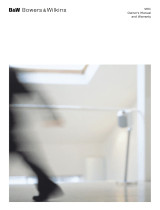 Bowers & Wilkins VM1 Owner's manual
Bowers & Wilkins VM1 Owner's manual
-
B&W CCM-636 Owner's manual
-
 Bowers & Wilkins CCM 817 User manual
Bowers & Wilkins CCM 817 User manual
-
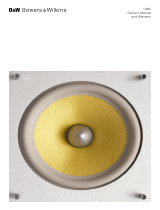 Bowers & Wilkins CMC User manual
Bowers & Wilkins CMC User manual
-
B&W DM 601 S3 Owner's manual
-
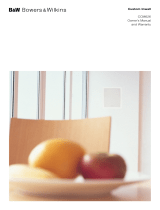 Bowers & Wilkins CCM 626 User manual
Bowers & Wilkins CCM 626 User manual
-
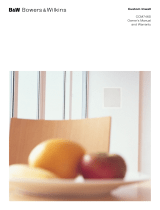 Bowers & Wilkins CCM646S User manual
Bowers & Wilkins CCM646S User manual
-
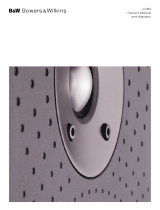 Bowers & Wilkins LCR3 User manual
Bowers & Wilkins LCR3 User manual
-
Bowers Wilkins DM 604 S3 User manual
Other documents
-
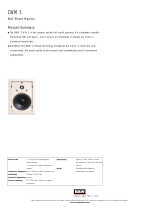 Bowers & Wilkins CWM5 User manual
Bowers & Wilkins CWM5 User manual
-
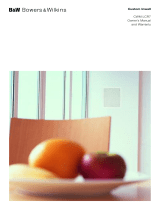 Bowers & Wilkins CWM LCR7 User manual
Bowers & Wilkins CWM LCR7 User manual
-
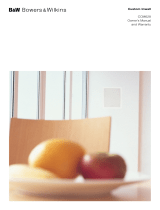 Bowers & Wilkins CCM-628 User manual
Bowers & Wilkins CCM-628 User manual
-
Bowers & Wilkins M-1 Owner's manual
-
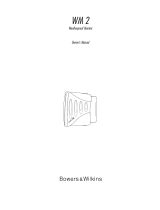 Bowers & Wilkins WM 2 User manual
Bowers & Wilkins WM 2 User manual
-
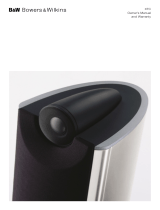 Bowers & Wilkins Speaker User manual
Bowers & Wilkins Speaker User manual
-
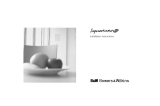 Bowers & Wilkins Signature 8NT User manual
Bowers & Wilkins Signature 8NT User manual
-
Bowers Wilkins CM6 S2 Owner's manual
-
Bowers & Wilkins 703 S2 Owner's manual
-
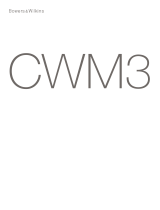 Bowers & Wilkins FP32319 Owner's manual
Bowers & Wilkins FP32319 Owner's manual
















































